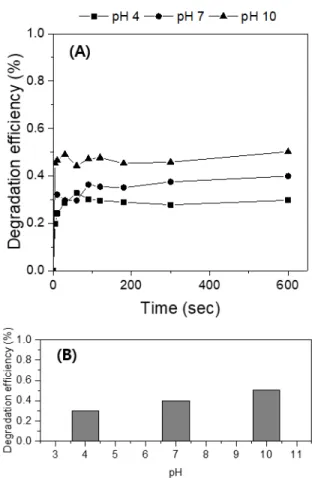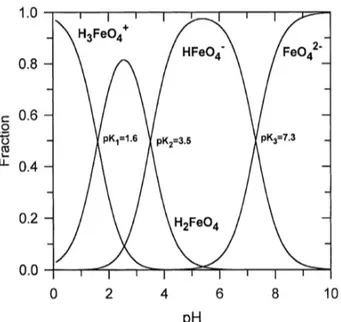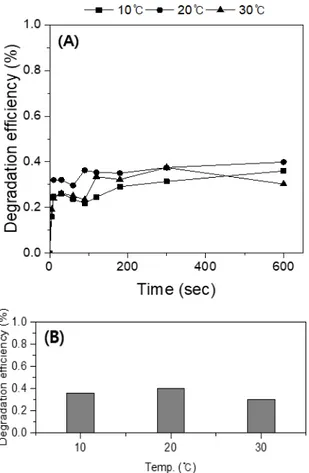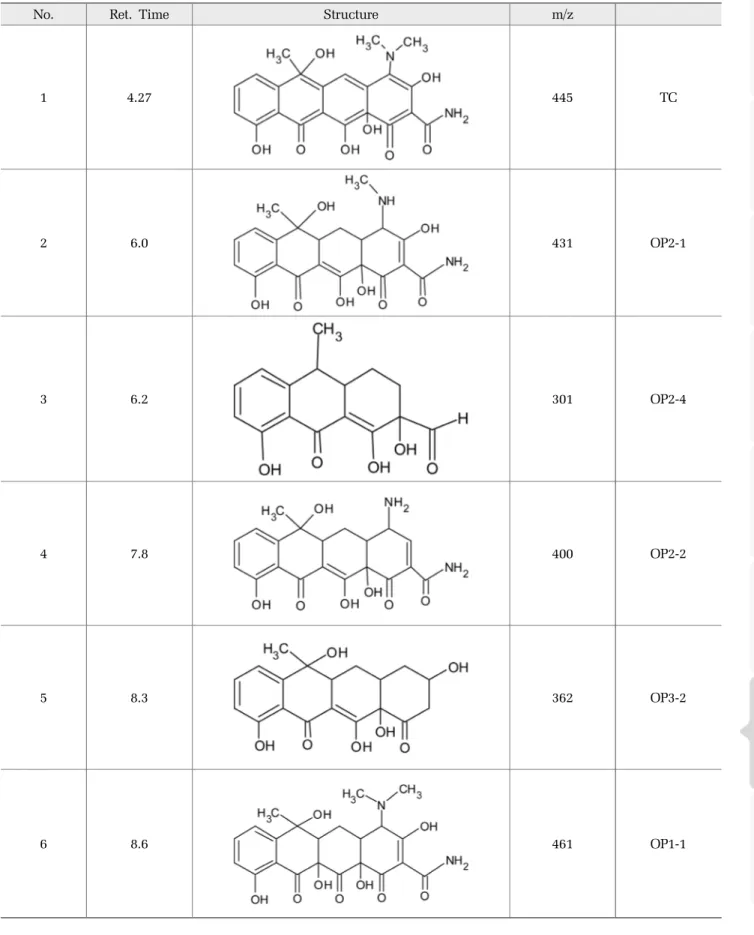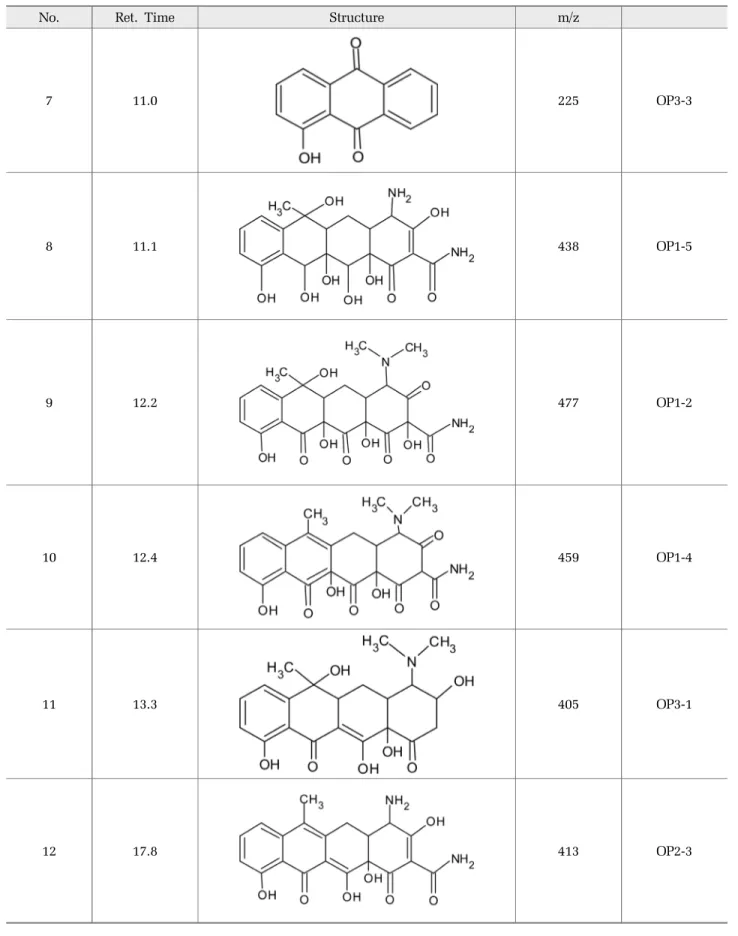1)
Received 8 December 2019, revised 6 February 2020, accepted 10 February 2020.
*
Corresponding author: Il-Kyu Kim (E-mail : ikkim@pknu.ac.kr)
This is an Open-Access article distributed under the terms of the Creative Commons Attribution Non-Commercial License (http://creativecommons.org/licenses/by-nc/3.0) which permits unrestricted non-commercial use, distribution, and reproduction in any medium, provided the original work is properly cited.
Liquid ferrate(VI)에 의한 다양한 수중 환경에서의 tetracycline 분해특성 및 중간생성물 연구
Degradation characteristics and intermediate study of tetracycline in aqueous system by liquid ferrate(VI)
박경덕1・강동환2・소윤환2・조정형1・김일규3*
Kyeong-Deok Park
1・Dong-Hwan Kang
2・Yoon-Hwan So
2・Joung-Hyung Cho
1・Il-Kyu Kim
3*1
부경대학교 마린융합디자인협동과정, 부산광역시 남구 용소로 45, 48513
2
부경대학교 환경연구소, 부산광역시 남구 용소로 45, 48513
3
부경대학교 환경공학과, 부산광역시 남구 용소로 45, 48513
1
Interdisciplinary Program of Marine Convergence Design, Pukyong National University, 45 Yongsoro, Nam-Gu, Busan 48513, Republic of Korea
2
Institute of Environmental Research, Pukyong National University, 45 Yongsoro, Nam-Gu, Busan 48513, Republic of Korea
3
Department of Environmental Engineering, Pukyong National University, 45 Yongsoro, Nam-Gu, Busan 48513, Republic of Korea
ABSTRACT
Tetracycline is one of the most commonly used antibiotics in domestic and foreign livestock industries to suppress the growth of pathogens. Tetracycline has been reported as a non-biodegradable compound. Therefore it has been not completely removed in the sewage treatment process. In this study, tetracycline was degraded using liquid ferrate (VI).
Based on these experiments, the optimal water condition (pH and water temperature) were selected, appropriate liquid ferrate (VI) dosage was calculated, and finally the degradation pathway was estimated with the intermediate products detected by LC/MS/MS. All degradation experiments were completed within 30 seconds and the optimal condition was obtained in basic condition (pH 10) at room temperature (20℃). And the appropriate molar ratio between tetracycline and liquid ferrate (VI) was 12.5:1. Finally, 12 intermediate products were detected with LC/MS/MS and the degradation pathways and the degradation pathways and proposed the degradation pathways.
Key words: Antibiotics, Liquid ferrate (VI), Intermediate study, Optimal aqueous condition, Tetracycline
주제어: 항생물질, 페레이트(VI), 중간생성물 연구, 최적 수중 조건, 테트라사이클린
1. 서 론
항생물질은 미생물에 의해 생성된 물질로 인간과 동물에 질병을 일으키는 병원균의 성장을 억제하는 의약물질을 의미한다. 이 중 tetracycline계 항생물질 은 축산업계에서 가장 많이 사용되는 항생물질 중 하나이며, 2013년부터 2017년까지 전체 축·수산용 항 생제 판매량의 약 20% 정도에 육박한다 (MAFRA et al., 2018).
그러나 항생물질은 2010년까지 축산업계에서 가축
의 질병예방 및 성장촉진의 목적으로 배합사료 내에 남용하여 왔으며, 이로 인해 내성균 출현 등의 문제가 발생하였다. 우리나라에서는 2004년부터는 배합사료 내 항생제 사용을 제한하여 왔다가 2011년부터는 전 면 금지하는 정책을 추진하여 특히 tetracycline계 항생
물질의 사용량이 크게 감소한 것으로 나타났다 (Kim
et al., 2015; Lim et al., 2014). 그러나 대신 자가 치료 및 예방용으로의 항생제 판매량이 증가하여 여전히 무분별한 사용이 우려된다 (Lim et al., 2014).
가축에게 체내로 투여되는 항생물질은 배설물 등의 형태로 배출된다. 이와 관련하여 Elmund et al. (1971) 은 항생물질의 75%가 본연의 상태로 배설된다고 보 고하였고, Kumar et al. (2005)과 Phillips et al. (2004)는 90%가 본연의 상태로 배설된다고 보고한 바 있다. 이 렇게 배출된 항생물질은 토양으로 이동하며, 강우로 인한 지표유출 및 지하로의 침투로 인해 지표수 및 지하수로 이동하게 된다 (Kemper, 2008; Tasho and Cho, 2016).
최근까지 tetracycline계 항생물질에 대한 심각한 위해 성은 보고된 바 없으나, Kim et al. (2014)과 Wollenberger et al., (2000)은 물벼룩 (D. magna)을 이용하여 각각 독 성과 생물농축성을 시험한 바 있다. 또한, 토양 중에 흡착된 tetracycline계 항생물질은 식물 등에 흡수될 수 있는데, Pan and Chu (2016)의 논문에서는 tetracycline 계 물질이 다른 항생물질에 비해 양배추나 토마토, 당 근, 오이와 같은 농작물에 흡수되어 식물 독성을 일으 키는 것으로 조사된 바 있다. Tetracycline은 또한 식물 내에 축적되어 인간에게까지 미칠 수 있을 것으로 우 려된다 (Pan et al., 2014).
가축분뇨는 축산분뇨처리장에서 1차 처리한 후 단
독공정으로 방류하거나 하수처리장으로 이송하여 2차 처리 후 방류한다. 그러나 대부분의 하수처리공정은
인과 유기물 처리를 위주로 하여 설계되었으므로 현 실적으로 유입수 내의 모든 항생물질을 처리하는 대 에는 한계가 있다 . Prado et al. (2009a)은 활성슬러지 법으로 tetracycline을 최대 89%까지 제거하였으나, Prado et al. (2009b)에서는 거의 제거되지 않아 생분해 법으로의 처리는 적합하지 않다고 보고하였다. 또한 Auerbach et al. (2007)의 연구에서는 Wisconsin 주에 위치하는 하수처리장 2곳의 활성슬러지를 분석한 결 과 총 10종의 tetracycline 내성균이 검출되었다. 그러 므로 하수처리장 공정을 거친 후 최종방류 직전에 항 생물질에 대한 추가설비를 설치하기보다는 고농도의 유입수 내에 존재하는 항생물질을 어느 정도 처리하 는 것이 생물학적 공정의 효율을 높이고 공정 내 내 성균 발생을 예방할 수 있을 것으로 판단된다.
수중 tetracycline을 처리하기 위한 기술로는 크게 흡 착공정과 고도산화공정으로 구분된다. 흡착공정에는 석탄계 및 목질계 활성탄을 이용하며, 회분식 또는 칼 럼흡착실험으로 tetracycline 흡착에 대한 흡착특성을 규명하는 연구가 대부분이다 (Jing et al., 2014; Liao et al., 2013; Son et al., 2008; Son et al., 2009; Son, et al., 2014a). 고도산화공정은 2000년대부터 항생물질을 대 상으로 한 연구가 본격적으로 시도되었으며, UV(Liu et al., 2015; Son et al., 2014b), H
2O
2(Chen et al., 2017), 오존(Hopkins and Blaney, 2014; Khan et al., 2010), 광 촉매(Cao et al., 2016; Yang et al., 2018; Zhu et al., 2013), 초음파(Safari et al., 2015; Wang et al., 2013) 등 다양한 기술을 적용하여 연구를 수행하였다. 그러나 흡착공정은 액상에 존재하는 물질을 고상(흡착제)으 로 옮기는 공정으로, 완전한 제거를 위해서는 연소 등 의 2차 처리가 필요하며, 고농도의 물질 처리 시 흡착 제 교체주기가 빨라져 유지비가 많이 소요되는 문제 가 있다 (Ha, 2015; Heo, 2006). 고도산화공정 중 UV 단독 공정은 몇몇 난분해성 물질의 분해에 효율적이 지 않으며, 오존의 경우 운전비용이 높고 발암성의 브 롬계 물질이 형성되는 문제가 있다 (Peing et al., 2015;
Yuan et al., 2011).
Ferrate(VI)는 강염기 조건에서 생성되는 6가철로,
강한 산화력을 가지고 있어 수질정화 및 병원균 제거
에 효과적으로 알려져 있다. 또한 반응 후 발암성 물
질인 브롬계 물질이 생성되는 오존과는 달리 산화 후
생성되는 3가철은 자연계에 해를 미치지 않고, 응집제
로도 작용할 수 있어 “green chemical”로도 불리기도
한다. 이미 phenol(Graham et al., 2004; Huang et al., 2001; Peing et al., 2015), chlorophenols(Graham et al., 2004; Park and Kim, 2016), bromophenols(Laksono and Kim, 2015; Laksono and Kim, 2017) 등의 페놀류, benzothriazoles(Yang et al., 2011), trichloroethylene, bisphenol-A(Han et al., 2015; Zhang et al., 2012)과 tetrabromobosphenol-A(Yang et al., 2014) 등의 난분해 성 물질들을 대상으로 한 연구에서 몇 분 내로 분해 하여 그 산화력을 입증하였으며, 최근에는 dichlofenac, ibuprofen, fluoroquinolones, sulfonamides 등의 의약물 질(Alvarez-Torrellas et al., 2016; Deng et al., 2019; Dong et al., 2017; Drzewicz et al., 2018; Feng et al., 2019;
Wang et al., 2015; Wu et al., 2018; Zhou and Jiang, 2015a; Zhou and Jiang, 2015b), 개인 위생물질(PPCPs)과 내분비계 장애물질(EDCs)(Yang et al., 2012)을 처리하 기 위한 연구도 활발히 진행 중에 있다.
Ma et al. (2012)는 25℃에서의 염기성 조건(pH 8 이 상)에서 연구를 수행한 바 있다. 본 연구에서는 liquid ferrate (VI)를 이용하여 보다 다양한 수중 조건(pH, 수 온) 하에서 tetracycline을 분해하고, 이를 기반으로 가 장 효율적인 분해를 수행할 수 있는 수중 환경을 선 정함과 동시에 tetracycline을 효과적으로 처리할 수 있 는 최적의 ferrate (VI) 양을 산정하고자 한다. 추가적 으로 ferrate (VI)를 이용하여 tetracycline을 분해할 경 우 생성되는 중간생성물들을 검출하고, 오염경로를 추정하고자 한다.
2. 연구방법 혹은 재료 및 실험방법
2.1 시약
본 실험의 모든 과정에는 1급 이상의 순도를 가진
시약만을 이용하였다. Tetracycline(99%)은 Alfa Aesar (USA) 사에서 구입하였고, stock solution을 제조하여 갈색병에 저온 차광상태로 보관하였으며, 제조 후 3일 내로 사용하였다. ferrate(VI)의 제조에 필요한 시약 중 Fe
2O
3(98%)와 Na
2O
2(95%)는 Alfa Aesar(USA)사에서, NaOH(97%)와 NaOCl(유효염소 >8%)는 Junsei(Japan)사 에서 구입하였다 . HPLC의 이동상으로는 NEW HUMAN UP 900(Korea, Human Co.) 초순수 제조기에서 생산되 는 초순수와 Burdick & Jackson(USA)사의 HPLC급 acetonitrile(ACN), Junsei(Japan)사의 H
3PO
4(>85%)를 사
용하였다. Tetracycline 수용액의 제조 시 pH 조절을 위해 사용된 phosphate buffer로는 NaH
2PO
4·2H
2O(99%, Kanto Chemical Co., Japan), Na
2HPO
4·12H
2O(>99%, Junsei, Japan), Na
3PO
4·12H
2O(>99%, Junsei, Japan), CH
3COOH(99.5%, Shinyo Chemicals Co., Japan)을 사 용하였다. 실험에 사용되는 tetracycline 반응 시약은 stock solution에 phosphate buffer를 약 15 mM을 첨가하 여 총 100 μM으로 하였다.
2.2 Ferrate(VI) 제조방법
Ferrate(VI)는 강염기 용액에 철염(Fe
2O
3, FeCl
3, FeNO
3, and etc.)을 투여함으로써 생성된다. 본 연구에 사용된 liquid ferrate(VI)는 Sharma (2015)가 제시된 방 법을 참고하였다 . 먼저 Na
2O
22.36 g과 Fe
2O
30.96 g을 혼합한 후, 550℃ 하에서 1시간 동안 가열하여 철 산 화물(Na
2FeO
2등)을 제조하였다. 그리고 NaOCl 8.6 mL에 NaOH 0.48 g을 혼합하여 제조한 염기성 용액에 2 g의 철 산화물을 투여하여 liquid ferrate(VI)를 제조 하였다. 제조된 liquid ferrate (VI)는 GF/F 유리섬유여 과지를 이용하여 여과 후 냉장상태로 보관하였다. 제 조된 ferrate(VI)는 pH 9.2의 buffer solution에 희석하여 UV-vis spectrometer로 510 nm에서 흡광도를 측정하였 으며, Sigma Aldrich 사에서 판매하는 ferrate(VI) (순도 97.0%)로 미리 작성한 검량선을 이용하여 그 농도를 확 인하였다 . 이와 같은 방법으로 측정된 ferrate(VI)의 농도 는 약 73,000 mg/L로 나타났다.
2.3 실험 및 분석 방법
실험에 사용된 반응기는 약 740 mL의 이중자켓 구 조로 되어 있으며, 일정한 수온을 유지하기 위해서 냉 각 장치로부터 외부관을 통해 냉각수를 주입하였다.
반응기 하단에는 magnetic stirrer를 설치하여 투입된 liquid ferrate(VI)가 즉시 용액과 혼합되도록 하였으며, 상단에는 pH meter와 수온계를 설치하여 주기적으로 pH와 수온을 점검할 수 있도록 하였다. 반응기 상단에 는 teflon으로 밀봉함으로써 외부와의 접촉을 차단하 였다.
Ferrate(VI) 주입 후 10분까지 일정 시간간격으로 반
응기 내부의 반응시약 5 mL를 채취하였으며, 채취한
반응시약에 바로 5 mM Na
2S
2O
3용액 1 mL를 주입함
으로써 반응시약 내에서의 ferrate(VI)로 인한 추가적
인 반응을 억제하였다. 그리고 0.2 μm nylon syringe filter로 필터링하여 분석시료로 사용하였다.
분석시료는 Shimadzu(Japan) HPLC-DAD를 이용하 여 분석하였다. HPLC에 장착된 칼럼은 Waters사 (USA) C18 SunFire Column(4.6×150 mm, 5.0 μm)이며, 온도는 40℃를 유지하였다. 이동상으로는 acetonitrile (solvent A)과 0.05% H
3PO
4가 포함된 초순수(solvent B) 를 시용하였으며, 이동상 유속은 0.1 mL/min으로 설정 하였다. 분석시료 중 20 μL를 HPLC에 주입하여 분석 하였으며, tetracycline을 검출하기 위한 DAD의 흡광도 는 350 nm로 설정하였다.
중간생성물 분석에 사용된 LS/MS/MS 기기는 UPLC/Xevo TQ - S micro(Waters, USA)이며, 칼럼은 Waters사(USA) ACQUITY BEH C18 Column(2.1×100mm, 1.7 μm)을 사용하여 분해산물을 정성분석하였다. 이 동상은 0.1% formic acid가 포함된 초순수(solvent A)와 0.1% formic acid가 포함된 acetonitrile(solvent B)를 Table 1의 운전조건으로 하여 100~600 m/z의 범위에 서 중간생성물 분석을 수행하였다.
Table 1. Analytical conditions of LC/MS/MS Description Analytical condition
Flow rate (mL/min) 0.2
Mobile phase A: 0.1% formic acid in water B: 0.1% formic acid in ACN
Gradient (A/B)
0 min: 90/10 10-17 min: 10/90 18/20 min: 90/10
Volume (μL) 5
Mode ESI, positive
3. 결 과
3.1 pH에 따른 tetracycline 분해효율
Liquid ferrate(VI)가 tetracycline을 분해하는 데 수중 pH가 미치는 영향을 알아보기 위하여 ferrate(VI) 주입 량을 2 μM로, 반응용액의 온도를 20℃로 고정한 상태 에서 pH를 산성 (4.0 ± 0.2), 중성 (7.0 ± 0.2), 염기성 (10.0 ± 0.2)으로 하여 실험을 수행하여 그 결과를 Fig.
1에 제시하였다.
모든 반응은 30초 이내에 완료되었으며, 최종적인
분해율은 반응용액이 염기성일 때 88%로 가장 높은 분해효율을 보였다. 그리고 중성일 때는 77%, 산성일 때는 58%로 pH가 감소할수록 분해효율이 선형적으로 감소함을 알 수 있다. 이는 Ma et al. (2012)이 실시한 선행연구와 비슷한 결과이며, 본 연구에서는 pH와 분해효율이 서로 비례한 것으로 나타났으나, 선행연 구에서는 pH가 11일 때는 오히려 감소하는 경향을 보여 pH 10일 때 가장 처리효율이 높은 것으로 판단 된다.
Tetracycline의 분해효율이 pH 7에서 가장 높은 이유 는 pH 변화에 따른 ferrate(VI)의 거동 변화로 설명할 수 있다. ferrate(VI)는 pH에 따라 총 4가지 화학종 (H
3FeO
4+, H
2FeO
4, HFeO
4-, FeO
42-)로 존재한다(Fig. 2).
이 중 FeO
42-는 pH가 6 이상일 때부터 존재하여 pH 10 이상일 때는 가장 우점하는 형태이며, 가장 안정적인 상태로 알려져 있다. 반대로 H
3FeO
4+는 pH 4 이하일 때
Fig. 1. Tetracycline degradation by liquid ferrate(VI) with
reaction time at different pH conditions (A) and final
degradation efficiency (B) (ferrate(VI) dosage: 2 μM,
Temp.: 20˚C).
Fig. 2. Species distribution of ferrate(VI) in aqueous solution (Sharma, 2002).
존재하는 형태이며, 반응성이 매우 크며 불안정한 상태이다. 그러므로 산성 상태에서는 비록 ferrate(VI) 의 반응성이 크나 불안정하여 3가 철로 쉽게 환원되기 때문에 tetracycline과 자가분해로 변환된 ferrate(VI)의 양이 많아져 산화반응이 충분히 일어나지 않은 것으로 보인다. 반대로 염기성 상태에서는 비록 ferrate(VI)의 반응성은 비교적 낮으나 tetracycline의 산화반응에 충 분한 반응성을 가지고 있으며, 비교적 오랫동안 존 재하므로 tetracycline의 산화반응이 원활이 이루어졌 을 것으로 보인다.
다른 하나의 이유는 pH에 따른 대상물질 자체의 이 온화와 관련이 있을 것으로 추측된다. Graham et al.
(2004)은 페놀과 클로로페놀류를 대상으로 pH 변화에 따른 분해 효율을 비교하였는데, 각 물질의 pH에 따른 이온화 정도에 따라 ferrate(VI)에 의한 분해 효율 또한 달라질 수 있다고 보고하였다. 그러므로 ferrate(VI)를
이용한 분해에는 대상물질의 pH 별 거동특성을 고려
할 필요가 있을 것으로 판단된다.
3.2 Ferrate(VI) 주입량에 따른 tetracycline 분해효율
Tetracycline을 분해하기 위한 최적의 ferrate(VI)의 양을 알아보기 위하여 tetracycline 수용액의 pH는 7, 수온은 20℃로 고정한 상태에서 ferrate(VI) 주입량을 1~10 μM으로 하여 실험을 진행하여 그 결과를 Fig. 3에
Fig. 3. Tetracycline degradation by liquid ferrate(VI) with reaction time at different ferrate(VI) dosage (A) and final degradation efficiency (B) (pH: 7.0±0.2, Temp.:
20˚C).
제시하였다.
실험 결과, 1 μM 주입 시 25%, 2 μM 주입 시 40%, 5 μM 주입 시 77%의 tetracycline가 제거되었으며, 8 μM과 10 μM 주입 시에는 거의 모든 tetracycline이 제거되어 Ma et al. (2012)이 제시한 결과와 유사함을 확인하였다.
또한 ferrate(VI) 주입량과 tetracycline 분해효율이 서로 비례하여 ferrate(VI) 주입량이 많을수록 더 많은 양의 tetracycline을 처리할 수 있는 것으로 나타났으나, 10 μM 주입 시에는 오히려 ferrate(VI)가 과량 주입되어 tetracycline을 분해하기 위한 최적 molar ratio ([tetracycline]:[Fe(VI)])는 12.5:1인 것으로 조사되었다.
3.3 수온에 따른 tetracycline 분해효율
수용액의 수온 변화와 ferrate(VI)에 의한 tetracycline
분해효율 간의 관계를 알아보기 위하여 pH는 7로,
ferrate(VI) 주입량은 2 μM로 고정한 상태에서 수온을 10℃, 20℃, 30℃로 변화하여 실험을 진행하였으며, 그 결과는 Fig. 4와 같다.
실험 결과 10℃에서는 36%, 20℃에서는 40%, 30℃
에서는 30%로 20℃일 때의 분해율이 높고 30℃에서 가장 낮은 것으로 조사되었다. 기존의 논문에서도 수 온에 따라 ferrate(VI)의 안정성이 달라진다는 연구결 과가 있으며, 수온이 증가할수록 주위의 열을 흡수하 여 더 강력한 산화력을 가진다. 그러나 강력한 산화 력으로 ferrate(VI)가 불안정하여 자가분해가 빠르게 일어나 높은 수온은 오히려 분해 효율이 감소하는 결 과를 초래하며, 반대로 수온이 감소할수록 ferrate(VI) 는 안정하나 반응성이 낮아져 반응이 억제되는 경우 를 보이기도 한다 (Wagner et al., 1952; Macova et al., 2009). 그러므로 tetracycline 분해를 가장 효율적으로 수 행할 수 있는 수온은 상온 범위(20~30℃)로 판단된다.
Fig. 4. Tetracycline degradation by liquid ferrate(VI) with reaction time at different water temperature (A) and final degradation efficiency (B) (pH: 7.0±0.2, ferrate(VI) dosage: 2 μM,).
3.4 중간생성물 분석 및 분해경로 제시
